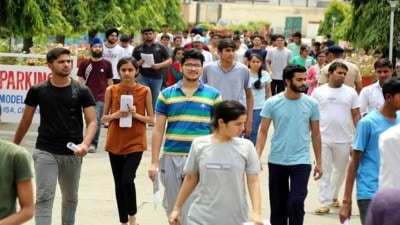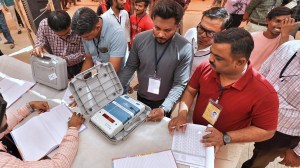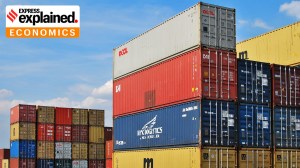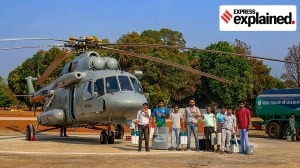- India
- International
Vehicles, dust or industry? Delhi will now know what’s causing pollution
Data is drawn round-the-clock and analysed through an automated system at Sarvodaya Bal Vidyalaya, Rouse Avenue, which functions as a ‘supersite’ for what is the newly launched real-time source apportionment study for Delhi.
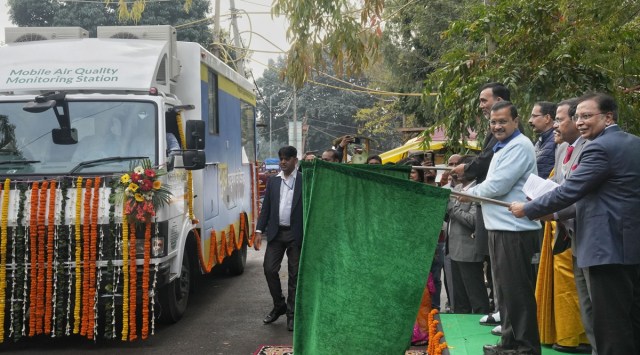 Kejriwal said more mobile vans can be launched eventually to collect data from different areas. (Express Photo by Abhinav Saha)
Kejriwal said more mobile vans can be launched eventually to collect data from different areas. (Express Photo by Abhinav Saha)Delhi now has real-time pollution data that’s publicly available on the extent of contribution of different sources — like vehicles, industry, road dust, coal and fly ash — to PM 2.5 levels in the city.
Data is drawn round-the-clock and analysed through an automated system at Sarvodaya Bal Vidyalaya, Rouse Avenue, which functions as a ‘supersite’ for what is the newly launched real-time source apportionment study for Delhi. The setup includes a mobile lab, which can be stationed at air pollution hotspots to determine sources of particulate matter there. The lab houses equipment including gaseous analysers and carbon analysers. In addition to estimating sources of PM 2.5 on an hourly basis, the system includes a forecasting mechanism, which provides an hourly AQI forecast for the next three days.

Chief Minister Arvind Kejriwal, who inaugurated the supersite and mobile lab on Monday said, “Till now, we have relied on one-off studies and based on that, policies have been made. The issue with this is pollution data changes daily and this is not factored into making policies. Until we calculate sources of pollution in real-time, we cannot have an effective policy… This system will give us information to take action and help us take micro-level steps…”
On the mobile lab, he said more such vans can be launched eventually to collect data from different areas. Real-time data can be accessed on the R-AASMAN portal: http://raasman.com/
At 1 am on Monday, for instance, the single largest contributor to PM 2.5 levels was secondary inorganic aerosols, which contributed around 36%, followed by vehicles which contributed around 23%, and ‘others’ (tyre and brake wear, paints, and plastic processing and melting) which contributed around 21% at Rouse Avenue. At 11 am, with a fall in pollution levels, contribution of vehicles had fallen to 7% and the single largest contributor with 47% was ‘others’.

Secondary inorganic aerosols are particles that are formed through interaction of different elements and could originate from various sources like brick kilns, power plants, vehicles and refineries. These aerosols are largely attributed to sources that are located far away, officials associated with the project said.
Mukesh Sharma, a professor at IIT-Kanpur, who is part of the project said: “Earlier, we would collect samples and analysis would take months. This data will now be available every hour. Forecasting component has also been strengthened… For forecasting, machine learning is being used. With air quality data from about 10 years at different locations, and wind speed, wind direction information, machine learning is being used for forecasting… if these are conditions, what will be the air quality.”
IIT Kanpur, IIT Delhi and The Energy and Resources Institute are involved with the study, with Delhi Pollution Control Commi-ttee being the nodal agency.
Sharma said the analysis would involve breaking pollutants into elementary compounds and around 20 ions. Ions help identify pollutants of secondary origin that may have travelled long distances, he explained. “Unless you go deeper into the particle, you cannot fine-tune decisions. We will be able to physically pinpoint sources and we can target them. At a ‘supersite’, measures are sophisticated…,” he said. Where the pollutants are coming from geographically will be identified post-data analysis and will be communicated to the DPCC, he added.
Meanwhile, Delhi BJP spokes-person Praveen Shankar Kapoor said any step in the fight against pollution is welcome, but the experience of the last eight years says the Delhi government is not at all serious to fight air pollution.
Apr 18: Latest News
- 01
- 02
- 03
- 04
- 05


